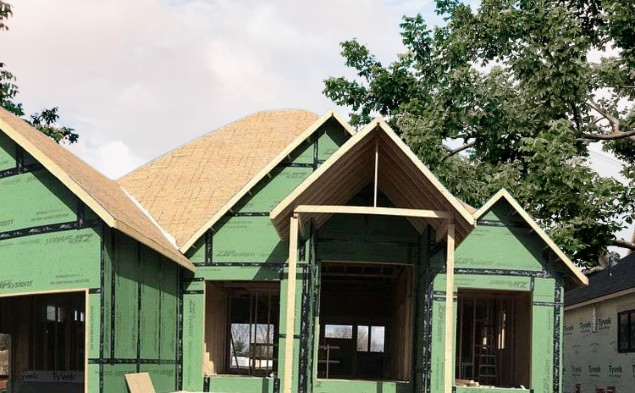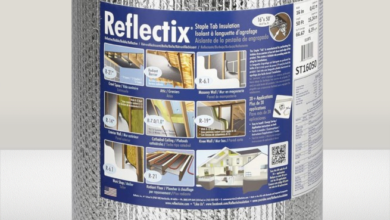Tyvek Over ZIP System

When constructing a home, air and moisture should be taken into consideration. These two have the potential to drastically lower your home’s comfort level while hastening the deterioration of materials like drywall and sheathing.
You can use products like Tyvek and the ZIP system to keep moisture and air out of your house. These two are frequently applied separately.
In other words, you have the option of using the ZIP system or Tyvek house wrap. Can Tyvek be used instead of the ZIP system, though? Let’s investigate.
Tyvek: What Is It?
Before the 1955 invention of Tyvek, contractors frequently waterproofed walls with tar paper. Tyvek house wrap was far more sophisticated than other wall waterproofing techniques when it was first developed. That is the reason it remains a well-liked option today.
Synthetic house wrap made of polyethylene fibers is called Tyvek. Tyvek is used as a house wrap in construction to keep air and moisture out of your house. It’s applicable to packaging as well.
It is quite breathable to use this house wrap. As a result, it keeps water out of your walls while allowing moisture to escape.
Additionally, Tyvek provides a microbial barrier for your walls. It stops asbestos, fiberglass, and mold—all dangerous building materials—from getting through. Tyvek’s high tensile strength makes it strong even though it is lightweight.
ZIP System: What Is It?
There have been numerous disagreements among contractors who argue that the introduction of the ZIP system meant the end for house wrap.
The most recent and inventive invention in the history of wall waterproofing and air barrier products is the ZIP system. It appears to be here to stay as well.
The ZIP system is an air and water barrier integrated sheathing system. Because this sheathing removes the need to install a house wrap, installing walls is made relatively simple.
Because of its integrated air and vapor barrier, this high-quality sheathing will guarantee comfort for many years to come.
Is It Possible To Install Tyvek Over A Zip System?
It is possible to install Tyvek over a ZIP system. However, you must ask yourself if it’s really necessary.
The purpose of Tyvek and the ZIP system is the same—to keep air and moisture out of your walls. It is not necessary to install Tyvek over the ZIP system.
You do not require an additional layer of house wrap as long as the ZIP system is installed correctly and the seams are taped in accordance with the manufacturer’s instructions.
Installing Tyvek over the ZIP system is not only superfluous, but it can also void Huber’s warranty. Consequently, if you added a Tyvek house wrap, they might not accept your claim if something were to happen to your ZIP system.
Remember that installing Tyvek over the ZIP system will waste money and defeat the purpose of advantages like the two-step ZIP sheathing installation.
Why Do Some Install Tyvek Instead of the ZIP System?
Tyvek has been in existence for some time. As a result, a lot of contractors are used to utilizing it on every construction project.
However, most people are unaware of the ZIP system’s inherent strength, which allows it to keep air and moisture out.
Some claim that covering the ZIP system with Tyvek improves your home’s ability to keep out moisture and air. However, that is untrue.
When properly installed, the ZIP system will shield your building from moisture and airflow. Adding an additional layer of Tyvek for air and waterproofing is not necessary.
Does Huber Suggest Installing a Zip System Over a Tyvek House Wrap?
It is evident from reading the ZIP system’s technical sheet that Huber does not advise using its product in conjunction with weather-resistant barriers (WRBs).
Tyvek is protected by barriers that withstand weather. Thus, using it in place of the Zip system could nullify Huber’s warranty.
The cost of the ZIP system is high. As such, you ought to refrain from utilizing any other products that might void its warranty.
Is Tyvek Necessary for the ZIP System?
A few reports exist regarding the failure of the ZIP system. However, given that this is a novel technology, that is not surprising. The majority of people neglect to tape the ZIP system’s seams, which let air and moisture through.
Nevertheless, the inefficiency of the product is not the reason for these ZIP system malfunctions. Errors in installation are the cause of them.
You won’t encounter any problems if you install the ZIP system in accordance with the manufacturer’s instructions.
In summary, a separate WRB like Tyvek is not required for the ZIP system. It does a fantastic job of keeping air and moisture out and is self-sufficient.
If something goes wrong with the ZIP system installation, you’ll only need to use Tyvek instead of OSB.
Is Tyvek Installation Recommended Above ZIP Sheathing?
It would be preferable if ZIP sheathing was not covered with Tyvek house wrap. That is due to a few different factors. First off, since the ZIP sheathing is airtight and waterproof, it adds no value.
Second, it eliminates any advantages that ZIP sheathing would provide. The ZIP system is designed to save you the trouble of installing house wrap.
You do not need to use the latter product if your goal is to install Tyvek over ZIP sheathing. The conventional method of building walls involves utilizing OSB, plywood, and Tyvek house wrap.
Zip System vs. Tyvek: Which is Better?
Tyvek shouldn’t be used over the ZIP system, as you now know. I know you’re wondering which of these two is a better option. Analyzing the benefits and drawbacks of each is the best way to draw a conclusion.
The ZIP system will be discussed first. Installing this system is not too difficult because you can build the waterproof barrier and sheathing at the same time.
As opposed to Tyvek, where sheathing must be installed before applying the house wrap. Here, two steps are combined. The ZIP system also has the benefit of not being damaged by wind. In addition, a thirty-year warranty is included.
The Zip system’s installation requires expertise, which is a drawback. If not, moisture can easily seep through the seams.
Should you choose this course of action, it must be installed by a qualified, licensed, and experienced contractor.
In addition, the cost is a little high, and the framing components are not positioned behind the waterproof covering. They are therefore vulnerable to water damage.
However, because the seams on Tyvek are lapped, it is very effective at waterproofing your house. It is extensively accessible and has been in use for many years. Because of this, almost any contractor can install it for you.
Tyvek’s drawback lies in the fact that it adds an extra installation step that you can omit by using the ZIP system. It is also very susceptible to wind-related damage.
When comparing the two, the ZIP system is superior to Tyvek. But since it’s a new technology, not everyone is on board with adopting it. However, exterior wall waterproofing is the way of the future.
Which option is best for you will depend on your goals and preferences. Nevertheless, you have to install it correctly and adhere to the manufacturer’s instructions whether you choose Tyvek or the ZIP system.
It’s a good idea not to combine them as well. Choose the ZIP system if that is how you feel about it, and vice versa.

